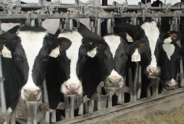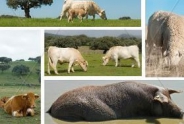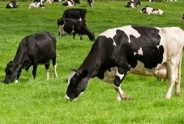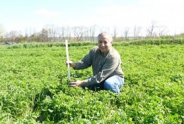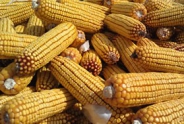First Cutting Updates - Week of May 15th, 2017
Betsy Hicks, Area Dairy Specialist
South Central New York Dairy & Field Crops
First Cutting Updates - Utilizing Alfalfa Heights as a Predictor for Quality
The SCNY team is monitoring alfalfa heights again this spring to help predict quality and %NDF for first cutting hay crop. Alfalfa height has been proven to be a reliable indicator of NDF values in the field for alfalfa, alfalfa/grass mixed and all grass stands. Results will be compiled and emailed on a weekly basis - please feel free to forward on. To be included on the weekly email, or to be removed from the email, please contact Betsy Hicks, bjh246@cornell.edu.
UPDATES FOR THE WEEK OF MAY 15th, 2017:
Comments from Janice: Mowing has begun and it's right on for clear grass fields since orchard grass is heading and other grasses will be heading in the next week. Alfalfa is approaching or at 2 ft this week. Only occasional early buds found. With the adequate soil moisture and the predicted heat for the week ahead we have the potential to gain significant yield in the next week to alfalfa. The weather windows and percent alfalfa will drive when to target harvest of mixed stands. The time is near and the switch from corn planting to hay harvest may be necessary to capture high quality. Wet fields will be a factor to consider when planning harvest. In soils that have been saturated or even waterlogged over the last 3 weeks the alfalfa is obviously stressed. It's growing very slowing and in some fields actually going backwards. There are spots of significant winter damage, mainly crown heaving. These fields are going to have a disappointing yield and may be candidates for turning into corn after first cutting.
Comments for Southern Counties (Broome, Tioga, Chemung, S Cortland): Most fields saw a good 3" of growth from last week and are above that 20" mark. Hill ground maybe a bit less, but valley ground a bit more. Several fields of triticale and fields of grass have been mowed already, as well as some fields of mixed alfalfa/grass. Fields continue to be drier here than the northern part of the region (I didn't have to use 4wd to access fields this week!), so I would expect more mixed fields to be knocked down in the coming week. Predicted dates to cut for a 50/50 mix in the southern counties is the end of this week to beginning of next week. Forecast looks like rain Thursday/Friday with a decent weekend, although cooler than the heat we're getting today and tomorrow. Pure alfalfa stands still have some time to gain yield while maintaining quality.
Comments for Northern Counties (Tompkins, N Cortland, Onondaga): Fields saw similar growth to the southern counties in our region - a good 3" overall, hovering around that high teens to low 20's in height. The heat and sun in the next two days will hopefully help to dry out conditions. Predictions for peak quality for a 50/50 mix are looking like this weekend. Don't be fooled by the amount of alfalfa in the stand - often we overestimate the amount in the stand and harvest it later than what the grass's peak quality is. The weekend looks like decent weather, so getting on those mixed fields may be a good idea. We still have time to gain yield in higher percentage alfalfa fields without sacrificing quality. Pure alfalfa stands have time to gain for sure - predictions to cut are still out there to around Memorial Day. The 10-day forecast looks like a small percentage of rain every day, so waiting on the weatherman to figure out his forecast won't hurt quality and will gain tonnage on pure stands in the meanwhile.
Thoughts on pure grass fields that are past peak quality: If you are able to segregate your first cutting, you may want to leave your fields that are past peak quality and save them for dry cow or heifer feed and focus on getting your mixed fields in at peak quality. Certainly, field conditions will play a role, but yield can be a factor to take into account as well.
Please let us know conditions you observe while harvesting, and any comments back about the alfalfa height project are appreciated! We also welcome any sample results you would like to share, so forward them on me, bjh246@cornell.edu. You can also post harvest pictures on our team's Facebook page - https://www.facebook.com/SCNYDairyandFieldCropsTeam/ and use the hashtag #harvest2017.
Additional Information:
The numbers that are indicators for using alfalfa heights for NDF content are as follows:
• 100% grass stands should be cut when nearby alfalfa is 14 inches tall, to achieve 50% NDF
• 50/50 mixed alfalfa/grass stands should be cut when nearby alfalfa is 22 inches tall, to achieve 44% NDF
• 100% alfalfa stands should be cut when alfalfa is 28 inches tall, to achieve 40% NDF
Predicted days to cut are based on daily NDF increases for grasses of 1.0% point, 50/50 mixed alfalfa/grass stands of 0.8% points, and alfalfa of 0.5% points and are adjusted for the coming week's weather. Typically NDF increases about 0.8 to 1.2 per day for grasses, with cooler weather being the lower end of the range and warmer weather being the higher end. For alfalfa, NDF increases about 0.4 to 0.7 per day, also dependent upon warm/cool weather.
The weekly email for the month of May will have a table of the locations around the region where we have measured the alfalfa height, as well as the elevation. Even if your fields aren't measured, you can use the location and elevation as a guide to conditions that may be similar to your own. We now cover six counties throughout South Central NY, including Tioga, Chemung, Broome, Tompkins, Cortland and Onondaga. Other teams and associations throughout the state are also measuring fields. For more information, contact that county's association to find out if fields are being measured there.
Alfalfa Heights - Week of May 15th, 2017 (pdf; 229KB)
Upcoming Events
Winter Bale Grazing Pasture Walk
January 10, 2026
Truxton, NY
Join us for the second Bale Grazing Winter Pasture Walk!
Have you heard about or seen bale grazing and wondered if it would work for you?
Do you want to learn the nuances and logistical context for implementing this regenerative practice?
Are you interested in seeing the impacts of bale grazing on land and animals from a practicing farmer?
If you answered Yes to any question, The Northeast Region National Grazing Lands Coalition, the Cornell Cooperative Extension Hillside Farms are teaming up to showcase our Second Bale Grazing Winter Pasture Walk!
Boots in the Barn: Webinar Series
January 13, 2026
Boots in the Barn: Cornell Dairy Research Updates
Webinar Series every Tuesday starting January 13th @ 12:00pm to February 24th.
2026 Winter Crop Meeting
January 22, 2026
Auburn, NY
Connect with the agricultural community and many key note speakers on the folllowing topics:
- Emerging Innovation in Plant Breeding and Technologies - A Peek at the Future by Ben Rogers, Pioneer Field Agronomist
- Managing Herbicide-Resistant Weeds in NY Corn & Soybean by Dr. Vipam Kumar, NYS Extension Weed Scientist, Cornell University
- Livestock Risk Protection (LRP) Insurance Program by KC Slade, Risk Management Specialist, Farm Credit East—Crop Growers
- Birds & the Bees Legislation and the Fate of Neonics by Janice Degni, Extension Field Crop Specialist
- Emerging Disease Pests and Soil Borne Diseases of Soybean by Dr. Camilo Parada Rojas, NYS Extension Plant Pathologist, Cornell University
- Solar Farms—Benefit or Detriment? by Mr. Michael McMahon, Chair, Homer Town Planning Board
4 DEC credits in categories 1A and 21-25. 1.5 PM, .5 CM and 1 PD CCA credits available.
Please send your DEC license number in the Notes to Us when you register on-line.
Announcements
USDA Contract Freezes and Terminations: Legal Action Steps for Farmers
For Farmers with Signed EQIP and CSP ContractsThis resource is written for farmers and ranchers nationwide who have a signed contract with USDA NRCS under the EQIP or CSP program for environmental improvements but have concerns that their contract is frozen, under review, or terminated, and who are uncertain of their rights to receive reimbursement as well as their ongoing obligations under the signed contract.
Version: 1.0
Issue date: Feb 28, 2025
A downloadable factsheet is available at our BUSINESS tab on the top of our webpage.
Additional Information: www.farmcommons.org
USDA Contract Freezes: Filing an NAD Appeal or Demand Letter
This resource is written for farmers and ranchers nationwide who have a signed contract with USDA NRCS under the EQIP or CSP program for environmental improvements and want more information on the mechanics of filing a National Appeals Division (NAD) appeal. This resource includes sample letters.
USDA NAD Appeal https://www.usda.gov/about-usda/general-information/staff-offices/office-hearings-and-appeals/national-appeals-division/nad-appeals
Farm Participants Needed for Bale Grazing Grant!
Information on the Project:- Approximately 10 acres total needed to bale graze two different bale densities
- "Core" farms will graze two winters, "Demo" farms will graze one winter.
- Payments for both "Core" farms and "Demo" farms
- Baseline soil sampling by bale grazing team
- Forage measurements in early season by bale grazing team
- Late season clipping if residual not trampled down by farm
Cornell Cow Convos - New Podcast
On-going podcast, New episodes released on the last Thursday of the month.Guest speakers, CCE Dairy Specialists.
Housed on Soundcloud Channel is CCE Dairy Educators
- Preventative healthcare for cows
- The trend of beef on dairy
- What to look forward to in the new year for dairy
- Socially grouping or pair-housing calves
2018 Drug Residue Prevention Manual
For more than 30 years, the U.S. dairy industry has focused educational efforts on the judicious use of antibiotics through the annual publication of a Best Practices Manual. The 2018 edition of the National Dairy FARM Program: Farmers Assuring Responsible Management? Milk and Dairy Beef Drug Residue Prevention Manual is the primary educational tool for dairy farm managers throughout the country on the judicious and responsible use of antibiotics, including avoidance of drug residues in milk and meat.The manual is a quick resource to review those antibiotics approved for dairy animals and can also be used as an educational tool and resource for farm managers as they develop on-farm best management practices necessary to avoid milk and meat residues. Visit the Manual and Form Library to download copies of this important tool!
Follow us on Facebook
The team updates our facebook page frequently - follow us to be updated on our events, see some fun videos and get local area updates!facebook.com/SCNYDairyandFieldCropsTeam
NYSERDA Agriculture Energy Audit Program
NYSERDA offers energy audits to help eligible farms and on-farm producers identify ways to save energy and money on utility bills. Reports include recommendations for energy efficiency measures.For more information and the NYSERDA Agriculture Energy Audit Program Application click here

